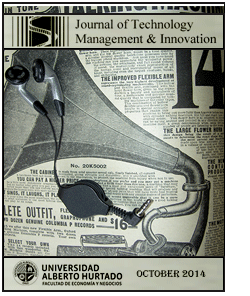Design Driven Innovation Practices in Design-preneur led Creative Industry
DOI:
https://doi.org/10.4067/S0718-27242014000300007Keywords:
creative industry, design driven innovation, design-preneur, design thinking, innovation.Abstract
Design driven innovation has emerged to be an alternative way to generate sustainable competitive products or services. Previous research has recently revealed succesful practices of design driven innovation in various industries. However, little has been known about the creative companies that practice design driven innovation, especially in developing countries. This research investigates the existence and practices of design-driven innovation in the Indonesian creative industry. Based on interviews with the design-preneurs of the creative industry, one of the results of this study reveals how the Indonesian creative industry creates new meanings that are embedded into new products. Based on the identification, a framework to create new meaningsis resulted which consists of a set of key processes, such as sensing, sensemaking, specifying, setting up and storytelling. The practical contribution of this research is that this identified framework can be adopted by any creative companies interested in improving their innovation capability.
Downloads
References
ABERNATHY, W., Clark, K.B. (1985). Mapping the winds of creative destruction. Research Policy, 14(1), 3-22. doi: 10.1016/0048-7333(85)90020-4
BEVERLAND, M., Farrelly, F. (2007). What does it mean to be design-led? Design Management Review, 18(4), 10-17. doi: 10.1111/j.1948-7169.2007.tb00089.x
BUCOLO, S., Matthews, J.H. (2010). Using a design led disruptive innovation approach to develop new services: Practising innovation in times of discontinuity. In: Kobe, C., Goller, I. (Eds.), Proceedings of the 11th International CINet Conference: Practicing Innovation in the Times of Discontinuity, CINet, Zurich, Switzerland, 176-187.
CHOO, C.W. (1996). The knowing organization: how organizations use information to construct
meaning, create knowledge and make decision. International Journal of Information Management, 16(5), 23-40. doi: 10.1016/0268-4012(96)00020-5
DOSI, G. (1982). Technological paradigms and technological trajectories: A suggested
interpretation of the determinants and directions of technical change. Research Policy, 11(3), 147-162. doi: 10.1016/0048-7333(82)90016-6
DC-UK (2008), Design Council Briefing, The Impact of Design on Business, October 2008,
London.
DOTI (2007), Department of Trade of Indonesia, Study of Creative Industry Indonesia 2007,
Jakarta.
DOTI (2008), Department of Trade of Indonesia, Plan Economic Development Creative
Indonesia 2009-2015, Jakarta.
EISENDHARDT, K.M. (1989). Building theories from case study research. Academy of Management Review, 14(4), 532-551. doi: 10.5465/AMR.1989.4308385
FLORIDA, R. (2002). The Rise of the Creative Class and How It’s Transforming Work, Leisure,
Community and Everyday Life. Basic Books, New York.
GLASER, B.G., Strauss, A.L. (1967). The Discovery of Grounded Theory: Strategies for
Qualitative Research. Aldine Publishing Company, Chicago. doi: 10.1093/sf/46.4.555
HENDERSON, R.M., Clark, K.B. (1990). Architectural innovation: the reconfiguration of existing product technologies and the failure of established firms. Administrative Science Quarterly, 35(1), 9-30.
IANSITI, M., Khanna, T. (1995). Technological evolution, system architecture and the
obsolescence of firm capabilities. Industrial and Corporate Change. 4(1), 333-361.doi: 10.1093/icc/4.2.333
KARTONO, S.S. (2010). Retrieved from wawancara-bersama-bapak-singgih-susilo-kartono/
KRIPPENDORFF, K. (2006). The Semantic Turn: A New Foundation for Design. Taylor and Francis, London.
LANDRY, C., Bianchini, F. (1995). The Creative City. Demos Publication, London.
LANKS, B. (2008). Craft on the Dial. Retrieved from http://www.metropolismag.com/dukwv2008/craft-on-the-dial.
LARASATI, D., Sudarmadji, B.W. (2008). Creating sustainable business through creativity and good product design: The success story of Mahanagari, ARTE-POLIS 2 International Conference and Design Charrette, Bandung, Indonesia.
NESTA (2008). Hidden Innovation in the Creative Industry. Research Report, NESTA London.
NUSSBAUM, B. (2009). Design thinking battle--managers embrace design thinking: Designers
reject it, Bloomberg BusinessWeek, July.
PRAHALAD, C.K., Santos, J., Pilat, D. (2009). New nature of innovation, Report to OECD, FORA OECD, Copenhagen, September.
SALDANA, J. (2009 ). The Coding Manual for Qualitative Researchers. Sage, London.
SCHONHARDT, S. (2011). Company tuned to sustaining resources. Retrieved from
SIGOLOTTO, D. (2010), Design driven innovation: Innovation strategies adopted in the furniture industry, Unpublished Master Thesis, Politecnico Di Milano, Facoltà Di Ingegneria, Milan, Italy.
UN (2010). Creative Economy: A Feasible Option. Creative Economy Report.
UN (2013). Widening Local Development Pathways. Creative Economy Report.
UTTERBACK, J.M., Vedin, B.A., Alvarez, E., Ekman, S., Sanderson, S., Tether, B., Verganti, R. (2006). Design Inspired Innovation. World Scientific Publishing, New York.
VALTONEN, A. (2007). Redefining industrial design: Changes in the design practice in Finland.
Unpublished Doctoral Dissertation, University of Art and Design, Helsinki.
VERGANTI, R. (2003). Design as brokering of languages: The role of designers in the
innovation strategy of Italian firms. Design Management Journal, 14(3), 34-42. doi:
1111/j.1948-7169.2003.tb00050.x
VERGANTI, R. (2006). Innovating through design. Harvard Business Review, 84(12), 114-122.
VERGANTI, R. (2008). Design, meanings, and radical innovation: A metamodel and a research
genda. Journal of Product Innovation Management, 25(5), 436-456. doi: 10.1111/j.1540-5885.2008.00313.x
VERGANTI, R. (2009). Design Driven Innovation. Harvard Business School Press, Boston.
WEICK, K.E. (1995 ). Sensemaking in Organizations.Sage, New York.
WIKU, (2014). A fusion of history and popular culture. Retrieved from
http://www.scoutnetworkblog.com/2012/03/10500/a-fusion-of-history-and-popular-`culture/
YANUARDI, R. (2012, April 27). Jewelry designs inspired by nature. jakartapost.com. Retrieved From http://www.thejakartapost.com/news/2012/04/27/jewelry-designs-inspired-nature.html
YIN, R.K. (2003). Case Study Research: Design and Methods. 3rd Ed., Sage, New York.
Downloads
Published
How to Cite
Issue
Section
License
Copyright (c) 2014 Journal of Technology Management & Innovation

This work is licensed under a Creative Commons Attribution-ShareAlike 4.0 International License.







